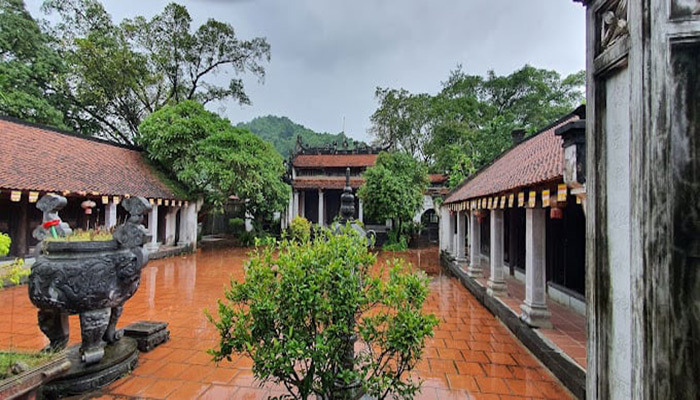Historical site - Pride of Ha Nam
On the land of Ha Nam, historical relics symbolising the nation's cultural identity, patriotism and perseverance have been preserved and taught for generations. These are not only places to record the past, but also the pride of Ha Nam province, contributing to the development of local culture, tourism and education.
First, Liem Can Commune, an ancient piece of land of Ha Nam, is located in the middle of the plain with low mountainous terrain and the winding Khuong Kieu River connecting the Chau River and Day River. This spiritual land has attracted many talented historical generals to choose it as a military training base and organise training against enemies, such as Dinh Bo Linh, Le Hoan and generals of the Dinh - Le dynasties. Lang Temple, considered an important historical and cultural relic, is the place to worship King Dinh Tien Hoang and other kings. Currently, only Ha Temple remains, at the foot of Lang Mountain, which was recognized as a national monument in 1999. Lang Temple played an important role in revolutionary propaganda and fighting the enemy during the resistance period. According to legend and genealogical records, every year Lang Temple organises 4 main festivals, also known as Dai Ky Phuc days, on January 10 (the birthdays of Le Hoan and Nguyen Minh) and on February 15, 8. /3, August 15 and November 21 according to the lunar calendar. In the past, these days, villagers celebrated solemnly and joyfully, with festivals, buffalo and pig slaughtering, folk games and art performances. Today, in the development of civilization, Dai Ky Phuc days are still celebrated with sacrificial rituals and orations, praising the merits of great kings and generals. The tradition of respecting relics and honouring the merits of ancestors is also maintained and passed down through generations. In particular, on the night of the 30th day of the New Year, many people go to Lang Temple to celebrate New Year's Eve before returning home to get lucky for the new year. In addition to the Mausoleum temple, on the ancient land of Bao Thai, there is also the tomb of Mr. Le Loc, grandfather of King Le Hoan, with majestic and majestic architecture. According to legend, at the end of the 10th century, Mr. and Mrs. Le Loc from their hometown of Truong An Thuong came to Bao Thai commune to work as net pullers and fish catchers. Mr. Le Loc built a thatched house at the top of Bao Cai mountain, which became the starting place for his career. One day, when Mr. Le Loc came to visit there, the bank broke and he was slapped to death by the tiger Son Truong, mistaken for a thief. After realising the mistake, the tiger carried Mr. Le Loc to the mountain for burial. Mr. Le Loc's grave later became known as the hidden grave or the tiger's grave. Mr. Le Loc's son, after looking after the tomb for 3 years, got married and gave birth to King Le Hoan. Mr. Le Loc's grave is located in the royal land, the hometown of "Previous Le Phat Tich". Currently, in the Lang temple, there are still rafters carved with the image of the tiger, reminding people of this ancient story when visiting and celebrating. Lang Temple is located in a beautiful natural setting of charming mountains and water, creating a harmonious and beautiful architectural work. This work still retains many precious architectural values, from sculptures on structures and hammock doors to worship objects, imbued with delicate and rare folk features. Lang Temple is also a religious symbol that the people created to honour the contributions of the two kings to the country. In important events of Liem Can commune and Thanh Liem district, such as military handover ceremony and sports congress, the procession of the flame from this temple to light the traditional flame has profound meaning, expressing the desire to convey the message of patriotism and national heroism. Preserving and promoting the value of monuments to educate future generations is necessary, while also creating a beautiful architectural landscape to serve people and tourists, helping them understand culture more deeply. and the history of Ha Nam in general and Thanh Liem in particular.
First, Liem Can Commune, an ancient piece of land of Ha Nam, is located in the middle of the plain with low mountainous terrain and the winding Khuong Kieu River connecting the Chau River and Day River. This spiritual land has attracted many talented historical generals to choose it as a military training base and organise training against enemies, such as Dinh Bo Linh, Le Hoan and generals of the Dinh - Le dynasties. Lang Temple, considered an important historical and cultural relic, is the place to worship King Dinh Tien Hoang and other kings. Currently, only Ha Temple remains, at the foot of Lang Mountain, which was recognized as a national monument in 1999. Lang Temple played an important role in revolutionary propaganda and fighting the enemy during the resistance period. According to legend and genealogical records, every year Lang Temple organises 4 main festivals, also known as Dai Ky Phuc days, on January 10 (the birthdays of Le Hoan and Nguyen Minh) and on February 15, 8. /3, August 15 and November 21 according to the lunar calendar. In the past, these days, villagers celebrated solemnly and joyfully, with festivals, buffalo and pig slaughtering, folk games and art performances. Today, in the development of civilization, Dai Ky Phuc days are still celebrated with sacrificial rituals and orations, praising the merits of great kings and generals. The tradition of respecting relics and honouring the merits of ancestors is also maintained and passed down through generations. In particular, on the night of the 30th day of the New Year, many people go to Lang Temple to celebrate New Year's Eve before returning home to get lucky for the new year. In addition to the Mausoleum temple, on the ancient land of Bao Thai, there is also the tomb of Mr. Le Loc, grandfather of King Le Hoan, with majestic and majestic architecture. According to legend, at the end of the 10th century, Mr. and Mrs. Le Loc from their hometown of Truong An Thuong came to Bao Thai commune to work as net pullers and fish catchers. Mr. Le Loc built a thatched house at the top of Bao Cai mountain, which became the starting place for his career. One day, when Mr. Le Loc came to visit there, the bank broke and he was slapped to death by the tiger Son Truong, mistaken for a thief. After realising the mistake, the tiger carried Mr. Le Loc to the mountain for burial. Mr. Le Loc's grave later became known as the hidden grave or the tiger's grave. Mr. Le Loc's son, after looking after the tomb for 3 years, got married and gave birth to King Le Hoan. Mr. Le Loc's grave is located in the royal land, the hometown of "Previous Le Phat Tich". Currently, in the Lang temple, there are still rafters carved with the image of the tiger, reminding people of this ancient story when visiting and celebrating. Lang Temple is located in a beautiful natural setting of charming mountains and water, creating a harmonious and beautiful architectural work. This work still retains many precious architectural values, from sculptures on structures and hammock doors to worship objects, imbued with delicate and rare folk features. Lang Temple is also a religious symbol that the people created to honour the contributions of the two kings to the country. In important events of Liem Can commune and Thanh Liem district, such as military handover ceremony and sports congress, the procession of the flame from this temple to light the traditional flame has profound meaning, expressing the desire to convey the message of patriotism and national heroism. Preserving and promoting the value of monuments to educate future generations is necessary, while also creating a beautiful architectural landscape to serve people and tourists, helping them understand culture more deeply. and the history of Ha Nam in general and Thanh Liem in particular.

Besides the beauty of Lang Temple, Truc Temple - Ngu Dong Thi Son is also a magnificent but little-known tourist destination. Located in Quyen Son village, Thi Son commune, Kim Bang, Ha Nam, this temple is located along the Day River, at the foot of Cam Mountain (also known as Cuon Son Mountain). This is not only a famous place for its beautiful natural scenery but also a place with a meaningful mile singing festival, honouring national hero Ly Thuong Kiet. According to legend, in 1089, when Ly Thuong Kiet's warships passed through Quyen Son village, a strong wind suddenly swept the army's large flag to the top of the mountain. Ly Thuong Kiet decided to stop and go ashore with his soldiers to pray for victory. Since then, this mountain has been named Cuon Son. To commemorate the merits of Ly Thuong Kiet, the villagers built a temple to worship him at this location, called Truc Temple today. The Truc Temple Festival takes place from the 10th of the first lunar month to the 6th of the second lunar month, with a special mom singing game including 30 performances, passed down from the reign of Ly Thuong Kiet and introduced to 16 countries around the world. In addition, Ngu Dong Thi Son includes 5 continuous caves stretching hundreds of metres, bringing interesting experiences to visitors. The scenery in the caves is very special, from bright light in the morning to magical light blue and purple paintings at noon and afternoon. Another highlight of the cave is the stone fairy rock, where it is said that fairies often come to celebrate and enjoy the beautiful scenery.
The historical relics of Ha Nam are not only symbols of the nation's glorious past but also an endless source of inspiration for current and future generations. They are the pride of every child of this province, a destination for tourists who want to explore the unique historical and cultural beauty of Ha Nam.










